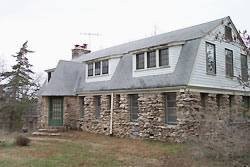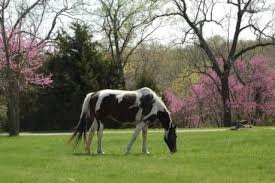Blackfeather Farm
Introduction
Text-to-speech Audio
This historic home was built by Nelson Studebaker Riley, a prominent Kansas City Business owner, on land previously owned by the BlackBob Native Americans Joseph and Johnson BlackFeather. The location most recently was home to an event space offering a variety of corporate and social events that focus on team building to help teach people in new ways and connect them to the land and themselves.
Images
Many events are held on the vast amount of land that the house sits on.

Black Feather Farm house built by Mr Riley.

One of the main attractions of the farm is now the ability to house and breed horses. Horses on the farm are also used for group training events.

Backstory and Context
Text-to-speech Audio
This land was awarded to a woman named Was Pea and her children. This land would stay in the family and be passed down from generation to generation until it landed in the hands of Joseph and Johnson Blackbob. Joseph and Johnson were BlackBob Native Americans who were part of the Shawnee Tribe. The Civil War had forced many Shawnee Native Americans to move due to threats from raiders and war. Joseph and Johnson were two of the few Shawnee Native Americans left in the area, however with so much land now left uninhabited settlers began to move in and fight over the land that one belonged to the Shawnee Tribe. Despite Joseph and Johnson having a claim to the land, the settlers would fight over the land for 20 years, forcing the Native people from the land and causing years of turmoil in the area.
Nelson Studebaker Riley was the eventual owner of the land that now houses Blackfeather Farm. Riley was the descendant of the founder of Studebaker-Packard Manufacturing Company. Riley would have the farm built on the land in 1928. The farmhouse was built as a summer retreat away from Riley’s job managing the Midwestern section of his family's business. In 1931, Riley lost the farmhouse and land to the Great Depression. The Fidelity Trust Bank gained control of the house and would allow private use of the property until 1934. In 1934 the land and house were bought by Sheffield Steel Company. They would then use this land for corporate fishing and their own shooting club. The Sheffield Steel Company owned BlackFeather Farm until 1947 when Thomas Richardson, owner of a Country Club Plaza shoe store, bought the house and land for his family. The Richardson family continues to own the farm and house. The current owner is Mary Richardson who uses the land as a locational for her motivational coaching job.
The farmhouse is true to the original style it was built in. It was meant to depict wealth and a well to do lifestyle that can be seen in the combination of styles the house was designed in. The farmhouse mimics Tudor Revival, Dutch Colonial Revival, and Craftsman houses. It consists of a cottage, barn, and chicken shed. As for natural features, the house is situated on a steep and rocky ledge located above Wolf Creek. The land also holds a one-acre lake and a natural spring.
Sources
Album.” 1996.
“Black Feather Farm.” Black Feather Farm Event & Equine Center, Black Feather Farm, www.Blackfeatherfarmllc.com/index.htm.
“Blackfeather Farm.” City of Overland Park, Kansas, City of Overland Park, www.opkansas.org/about-overland-park/historical-landmarks-in-overland-park/Blackfeather-farm/.
